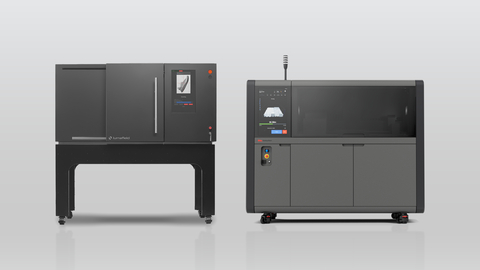Desktop Metal and Lumafield Introduce Supply Chain Resilience Solution to Help Manufacturers Easily Scan and 3D Print Parts
Desktop Metal and Lumafield have introduced a Supply Chain Resilience package to address manufacturing challenges. This innovative solution combines CT scanning and 3D printing, enabling manufacturers to scan and reproduce high-demand parts without needing original CAD models. The collaboration, prompted by supply chain disruptions, allows quick digitization of legacy parts. Customers purchasing a Desktop Metal printer by July 1, 2022, will receive 15 CT scans and engineering support while awaiting their scanner. This technology aims to enhance production efficiency and reduce supply chain risks.
- Launch of a Supply Chain Resilience package combining CT scanning and 3D printing.
- Addresses manufacturing challenges by allowing quick digitization of legacy parts.
- Increases production efficiency and reduces supply chain risks.
- Customers purchasing by July 1, 2022, receive 15 CT scans and engineering support.
- None.
CT scanning and 3D printing package can quickly and accurately produce high-demand parts without original CAD models

To address the manufacturing industry’s supply chain challenges,
As a result of the COVID pandemic, manufacturers have been faced with historic supply chain disruptions, along with wide swings in pricing and inventory – a challenge highlighted by the Biden Administration’s recent announcement of the AM Forward initiative to strengthen
Additive manufacturing offers the ability to cost-effectively in-source production and reduce supply chain risk, but often requires manufacturers to have CAD models of their parts. That has been a significant barrier; manufacturers often rely on thousands or millions of parts, many of which were designed years ago and don’t have associated CAD files. 3D scanning has been proposed as a solution, but it’s limited to capturing exterior part features.
The Supply Chain Resilience package from
Lumafield’s CT platform digitizes parts with a series of X-ray images that capture both external and internal features in detail, using powerful cloud-based software to create a 3D model that can be exported as a mesh representation for 3D printing.
Desktop Metal’s software and 3D printers can then turn those mesh models back into high-quality metal or polymer parts, making it possible to seamlessly replace legacy manufacturing processes with in-house 3D printing.
“Manufacturers have wanted to replace legacy fabrication processes with 3D printing for a long time, but digitalization of parts has been a barrier,” said
“The last two years have been profoundly disruptive, and we cannot expect our supply chains to return to normal,” said
Supply Chain Resilience Package Details
Customers interested in pairing a Lumafield scanner with a
- All metal printers, including the Desktop Metal Shop System™, which was built as a turnkey solution for smaller enterprises and is offered in a 4-, 8-, 12- or 16-liter package. Also included: the Studio System™, X-Series and all Production System™ models, which includes the P-1 and P-50 – the latter of which is the world’s fastest system to 3D print metal parts at scale.
- All ETEC DLP polymer 3D printing systems, which includes the D4K, P4K, Envision One XL or Xtreme 8K, which offer a wide range of price points, build volumes and potential polymer material sets, including elastomers, hard plastics, high temperature plastics, and biocompatible materials.
Lumafield’s Neptune scanner is a revolutionary advance over legacy CT systems. It’s at home in any office or workshop environment, ready to become an everyday tool for entire engineering teams. With a user-friendly touchscreen and AI-powered configuration, anyone can use it with minimal training—no dedicated operator required.
Lumafield’s cloud-based Voyager software turns scans into actionable insights and is included with every Neptune scanner. In addition to producing mesh exports for 3D printing, it offers intuitive visualizations that reveal invisible features, measurement tools that take guesswork out of inspection, and a powerful automated analysis engine that pinpoints voids, pores, and cracks before they turn into critical problems. Voyager runs in the cloud, accessible through any desktop web browser, so teams can collaborate and share data in real time.
The Supply Chain Resilience package is available to any company that purchases a
For more information, visit:
https://learn.desktopmetal.com/supplychain_lumafield_package
https://promotions.lumafield.com/supply-chain-resilience-package
About
About Lumafield
Lumafield, based in
Forward-looking Statements
This press release contains certain forward-looking statements within the meaning of the federal securities laws. Forward-looking statements generally are identified by the words “believe,” “project,” “expect,” “anticipate,” “estimate,” “intend,” “strategy,” “future,” “opportunity,” “plan,” “may,” “should,” “will,” “would,” “will be,” “will continue,” “will likely result,” and similar expressions. Forward-looking statements are predictions, projections and other statements about future events that are based on current expectations and assumptions and, as a result, are subject to risks and uncertainties. Many factors could cause actual future events to differ materially from the forward-looking statements in this document, including but not limited to, the risks and uncertainties set forth in
View source version on businesswire.com: https://www.businesswire.com/news/home/20220516005516/en/
Press Contacts:
lyndamckinney@desktopmetal.com
(978) 224-1282
Lumafield
jh@horizonpr.com
Source:
FAQ
What is the Supply Chain Resilience package announced by DM?
How does the partnership between Desktop Metal and Lumafield benefit manufacturers?
What benefits do customers receive when purchasing a Desktop Metal printer?
What technologies are included in the Supply Chain Resilience package?







